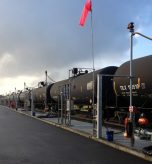A Strategic Analysis for South American Logistics Professionals
March 2025
Executive Summary
The global shipping landscape is experiencing unprecedented disruptions that are reshaping trade routes and creating new opportunities for alternative shipping methods. This white paper examines the emerging potential for break-bulk shipping between South America and North America, analyzing how current container market disruptions are creating favorable conditions for this traditional yet adaptable shipping method.
Break-bulk shipping—the transportation of cargo in separate pieces rather than in containers—is experiencing a renaissance as global supply chains adapt to multiple simultaneous challenges. For South American logistics professionals, this presents a strategic opportunity to diversify service offerings, mitigate risks, and capture new market segments in the North American trade through enhanced supply chain optimization services.
This analysis provides a comprehensive overview of current market conditions, identifies key opportunity areas, and offers strategic recommendations for South American logistics consultants and companies looking to capitalize on these developments.
Current Market Landscape
Global Shipping Disruptions
The international shipping industry is currently facing multiple simultaneous challenges that are disrupting traditional container routes and demanding innovative industrial supply chain management approaches:
- Red Sea Crisis: Attacks on commercial vessels have severely impacted shipping through the Suez Canal, with transits decreasing by 42% compared to peak levels. According to UNCTAD, container ship transits have fallen by 67%, with significant declines in container carrying capacity.
- Panama Canal Constraints: Water level issues have reduced Panama Canal capacity by 49%, significantly impacting a critical artery for South American trade. According to UNCTAD, “approximately 26% of Ecuador’s trade volumes cross the canal. The share is around 22% for both Chile and Peru.”
- Port Congestion: Major terminal operations management challenges continue to cause bottlenecks at ports, with delays creating ripple effects throughout manufacturing supply chains.
- Container Imbalances: Shortages in key locations and surplus in others are creating inefficiencies in the container shipping market, requiring specialized logistics optimization strategies.
- Labor Uncertainties: As noted by shipping expert Nerijus Poskus from Flexport, “People are very aware of what may happen” regarding potential labor disruptions at North American ports, particularly with the ILA contract expiring in late 2024.
South America-North America Trade Dynamics
The South America-North America shipping corridor presents unique characteristics that make it particularly suitable for break-bulk opportunities and enhanced marine logistics services:
- The South American freight and logistics market is projected to grow from $244.27 billion in 2025 to $311.70 billion by 2030, representing a CAGR of 5.00%, according to Mordor Intelligence.
- Brazil is leading transformation through substantial infrastructure investments, with an ambitious target of attracting $34.03 billion in private investments for new rail and highway projects between 2024 and 2026.
- According to the Inter-American Development Bank, logistics disruptions in specific foreign markets can spread throughout the entire network, affecting freight rates across regions and highlighting the need for advanced logistics procurement strategies.
- The Americas have strong historical trade connections in commodities that are well-suited for break-bulk shipping, including lumber, raw metals, heavy machinery, and agricultural products.
Break-Bulk Shipping: An Opportunity Analysis
Key Advantages in the Current Market
- Flexibility in Port Selection: Break-bulk vessels can access smaller or less-developed ports that may not have container handling infrastructure, expanding potential service points along both North and South American coasts and providing more options for warehouse site selection.
- Reduced Dependency on Container Availability: As noted by Latin American Cargo, “Break-bulk cargo transportation entails dismantling large units into smaller, more manageable ones,” reducing reliance on scarce container equipment and enabling more resilient procurement logistics and supply chain management.
- Specialized Cargo Handling: Break-bulk is ideally suited for oversized, project, and heavy-lift cargo that doesn’t fit standard containers—a growing segment as infrastructure development accelerates across the Americas, requiring specialized manufacturing logistics expertise.
- Route Flexibility: Break-bulk vessels can more easily adapt routing to avoid congested areas or take advantage of alternative passages when main shipping channels are constrained, offering advantages for marine logistics companies.
- Market Timing Advantage: During major shipping cycle disruptions, businesses tend to move away from term contracts toward spot markets, creating opportunities for industrial consulting services offering alternative solutions.
Prime Cargo Categories for Break-Bulk Opportunity
The following cargo types present the strongest opportunities for break-bulk shipping between South America and North America:
- Heavy Machinery and Equipment: Mining, construction, and agricultural equipment movements are growing as infrastructure investments increase across South America, requiring specialized manufacturing supply chain consultants.
- Raw Materials: Lumber, metals, and construction materials that can be efficiently transported in bulk rather than containerized.
- Project Cargo: Energy infrastructure components, including renewable energy equipment (wind turbine parts, solar arrays), which often exceed standard container dimensions and require terminal logistics expertise.
- Agricultural Products: Certain agricultural exports that don’t require containerization, including some grains and forestry products.
- Industrial Metals: Steel products, copper, and other metals that have traditionally moved via break-bulk methods.
Regional Market Assessment
Most Promising South American Origins
- Brazil: As the largest economy in South America, Brazil represents the most significant origin market. Major ports like Santos offer established break-bulk handling capabilities and growing infrastructure investments, making it ideal for supply chain design consultants.
- Chile and Peru: These Pacific coast nations, highly dependent on the Panama Canal (22% of their trade), have strong incentives to diversify shipping methods amid canal constraints.
- Argentina: With substantial agricultural and mining exports, Argentina presents opportunities for break-bulk shipping of commodities to North America and requires specialized manufacturing process consultants.
- Colombia: Growing industrial output and strategic position with both Atlantic and Pacific coasts make it an attractive origin for diversified shipping methods.
Key North American Destinations
- S. Gulf Coast: Ports like Houston and New Orleans have extensive experience with break-bulk cargo and connections to industrial centers, offering ideal manufacturing site selection opportunities.
- Eastern Seaboard: Philadelphia, Baltimore, and other ports with strong break-bulk capabilities and access to major population centers.
- Great Lakes: Accessible during shipping season via the St. Lawrence Seaway, offering direct access to the industrial heartland.
- Specialized Port Facilities: Smaller ports with specific break-bulk expertise that may be less congested than major container terminals and offer efficient terminal operations management.
Strategic Recommendations for South American Logistics Providers
Immediate Action Items
- Conduct Cargo Assessment: Analyze current container shipments to identify cargoes that could be economically converted to break-bulk with the help of market analysis consultants.
- Build Partner Networks: Establish relationships with specialized break-bulk carriers and terminal operators in target North American ports, leveraging due diligence consultants to validate potential partners.
- Develop Specialized Expertise: Invest in training staff on break-bulk handling, documentation, and regulatory requirements to enhance logistics consulting capabilities.
- Create Pilot Programs: Start with small-scale break-bulk shipments to test processes and establish performance benchmarks, applying lean manufacturing consultant methodologies to optimize operations.
Medium-Term Strategy
- Specialized Equipment Investment: Consider investments in cargo handling equipment specifically designed for break-bulk operations, working with manufacturing consultants to optimize selections.
- Integrated Solutions: Develop end-to-end logistics packages that combine break-bulk ocean transport with inland logistics through advanced supply chain technology implementation.
- Digital Transformation: Implement digital tracking and management systems specifically designed for break-bulk cargo visibility from supply chain technology companies.
- Customer Education: Develop educational materials for clients on the advantages of break-bulk shipping in the current market environment, positioning your firm as leading manufacturing supply chain consultants.
Risk Assessment and Mitigation
While break-bulk shipping presents significant opportunities, several risks must be managed with proper manufacturing consulting services:
- Operational Complexity: Break-bulk requires more labor-intensive handling than containerized cargo. Mitigation: Invest in specialized training and equipment to improve efficiency.
- Weather Susceptibility: Some break-bulk cargo may have greater exposure to weather elements. Mitigation: Implement proper packaging standards and insurance coverage.
- Market Volatility: Break-bulk rates may fluctuate based on vessel availability and demand. Mitigation: Develop a mixed portfolio of contract types, including both spot and term arrangements, guided by logistics procurement expertise.
- Regulatory Compliance: Varying documentation requirements across jurisdictions. Mitigation: Establish a dedicated compliance team familiar with break-bulk requirements.
Industry Expert Perspectives
Nerijus Poskus, Global Head of Ocean Procurement at Flexport, notes: “When disruptions happen and you’re on spot, you can change carriers, routes, whether you go to the West Coast, East Coast or Gulf Coast. You can shift to premium service when you need to, then back to regular service.”
According to Fernando Leibovici, Economist at the Federal Reserve Bank of St. Louis: “Localized disruptions –especially those occurring in hubs—can reverberate throughout the entire network,” highlighting the interconnected nature of global shipping that creates opportunities for alternative methods.
Christian Volpe Martincus, Principal Economist at the Inter-American Development Bank, emphasizes: “The degree of the world’s interconnectedness needs to be seriously considered. Logistics disruptions in given foreign markets can spread throughout the entire network,” further highlighting the need for diversified shipping strategies.
Conclusion
The convergence of multiple shipping disruptions—from the Red Sea crisis to Panama Canal constraints—has created a unique window of opportunity for break-bulk shipping between South America and North America. For South American logistics professionals, this represents not merely a temporary alternative but a strategic opportunity to diversify service offerings and capture new market segments through enhanced marine logistics company services.
By developing specialized expertise in break-bulk shipping, building strategic partnerships with terminal operators and carriers, and educating clients on the advantages of this approach, South American logistics consultants can position themselves advantageously in this evolving market landscape.
The success of this strategy will depend on careful cargo selection, operational excellence, and the ability to adapt to changing market conditions. However, for those willing to invest in developing break-bulk capabilities, the current disruptions in the container market represent not a crisis but an opportunity for innovation and growth supported by advanced supply chain optimization services.
References
- United Nations Conference on Trade and Development (UNCTAD). (2024). “Unprecedented shipping disruptions raise risk to global trade, UNCTAD warns.”
- Mordor Intelligence. (2025). “South America Freight And Logistics Market Size & Share Analysis.”
- (2025). “Dry Bulk Shipping Market to Grow by USD 3.60 Billion from 2025-2029.”
- Inter-American Development Bank. (2022). “How are Global Shipping Disruptions Affecting Latin American Freight Rates?”
- (2023). “Container shipping outlook 2024: Rising risk of delays, disruptions.”
- Louis Fed. (2024). “Shipping Disruptions in the Red Sea: Ripples across the Globe.”
- Latin American Cargo. (2022). “Break Bulk Shipping Services.”
- Ameritrans Freight. (2025). “Easy and Secure Shipping to South America.”
- Business Research Insights. (2025). “Dry Bulk Shipping Market Size, Growth Outlook 2025-2033.”
- Cognitive Market Research. (2025). “Global Dry Bulk Shipping Market Report 2025 Edition.















